- Study Documents
- Learning Tools

Writing Guides
- Citation Generator
- Flash Card Generator
- Homework Help
- Essay Examples
- Essay Title Generator
- Essay Topic Generator
- Essay Outline Generator
- Flashcard Generator
- Plagiarism Checker
- Paraphrasing Tool
- Conclusion Generator
- Thesis Statement Generator
- Introduction Generator
- Literature Review Generator
- Hypothesis Generator
- Human Editing Service
- Essay Hook Generator
Writing Guides / How to Write a Literature Review with Examples
How to Write a Literature Review with Examples

Introduction
Writing a literature review is a necessary and important step in academic research. You’ll likely write a lit review for your Master’s Thesis and most definitely for your Doctoral Dissertation. It’s something that lets you show your knowledge of the topic. It’s also a way to show off yourself as an expert in the area. The literature review establishes the fact that you’ve done your due diligence.
For your reader, it is a good way to communicate just what is out there in terms of existing knowledge about your research topic. The lit review allows you to summarize and assess the current state of research, by bringing together and synthesizing available studies on the matter.
Ultimately, the literature review lets you present a summary of the body of knowledge and use that to identify research gaps that you can then try to fill. It is incredibly helpful in setting up a theoretical framework and justification for your own study.
This guide will help you understand what is a literature review so that you’ll know its value and importance, as well as how to write one effectively.
What is a Literature Review?
A literature review is a synthesis and critical analysis of research relevant to a specific topic or research question that you have raised for study. It is more than a summary of sources; it is a critical evaluation that weaves together current and past literature to reveal patterns, theoretical insights, research directions, and research gaps.
The main point of a literature review is to show a well-rounded understanding of the state of the topic with regard to existing studies. It helps researchers position their work in the context of what is already known, how it fits, why it is necessary, or how it extends the current understanding.
It also serves to build a solid foundation for further research, by acting as a backdrop against which new research contributions can be made.
Importance of a Literature Review in Academic Research
A literature review is necessary as it will serve several purposes for your research:
- Understanding the Field : First, the literature review provides an overview of the existing body of knowledge, which helps researchers understand the scope of previous studies and what has already been uncovered in the field.
- Identifying Gaps : Second, when they look at existing literature, researchers can more easily identify where research is lacking or where questions remain unanswered. These gaps form the justification for new investigations.
- Critical Analysis : Third, a literature review allows the researcher to critically analyze how previous studies have been conducted, what methodologies were used, what evidence was uncovered, whether they sufficiently addressed the research problem, or what areas of research are still needed.
- Theoretical Framework : Fourth, the literature review acts as support for the development of a theoretical framework with which the research can be conducted and interpreted, as it grounds the study in ideas based existing data.
Types of Literature Reviews
There are different types of literature reviews for different purposes. Knowing when to use each type will help you shape your own review.
Narrative Review
A narrative review gives an overview of the topic by focusing on the development of theories and concepts over time. It is often descriptive and used when only a brief review is possible. Its weakness is that it lacks the systematic methodology of more structured reviews. However, narrative reviews are useful for obtaining a quick understanding of the topic and where research has focused in the past.
Systematic Review
A systematic review is more rigorous than a narrative review. It has a very methodical approach to searching for and reviewing existing literature. This type of review is characterized by its well-defined research question and a detailed, reproducible methodology that allows for the collection, critical appraisal, and synthesis of all relevant evidence. Inclusion and exclusion criteria are stated. Due to their structured and transparent nature, systematic reviews are particularly prevalent in fields like healthcare and social sciences, where evidence-based conclusions are needed for guiding practice and policy decisions.
The methodology of a systematic review begins with the precise formulation of a research question, which serves as the foundation for the entire review process.
Next, a fully detailed search strategy is developed so that all relevant studies are identified. The researcher will usually require access to multiple databases and literature types (white and grey papers, etc.). The inclusion and exclusion criteria must be explicitly defined to show which studies will be considered and which will be excluded, based on predetermined factors like study design, population, year published, language, and relevance to the research question.
Finally, the data extraction and analysis phase involves systematically gathering data from the selected studies and conducting a detailed analysis, which may include quantitative synthesis (like meta-analysis) or a qualitative assessment of the evidence. This approach allows the researcher to make sure the findings are robust, reliable, and can be replicated in future research.
Theoretical Review
A theoretical review looks at theories relevant to a particular area of study. It focuses on conceptual frameworks that have been developed to explain phenomena, analyze theories’ strengths and limitations, and propose new theoretical approaches if necessary. These reviews are helpful when the research is going to explore or challenge existing theoretical assumptions.
Integrative Review
An integrative review synthesizes existing research to generate new perspectives or frameworks. Unlike systematic reviews, integrative reviews will use both qualitative and quantitative studies and offer a broader analysis of the literature. This type is helpful for researchers who want to develop new and deeper insights and more holistic theories by integrating a wider array of research findings.
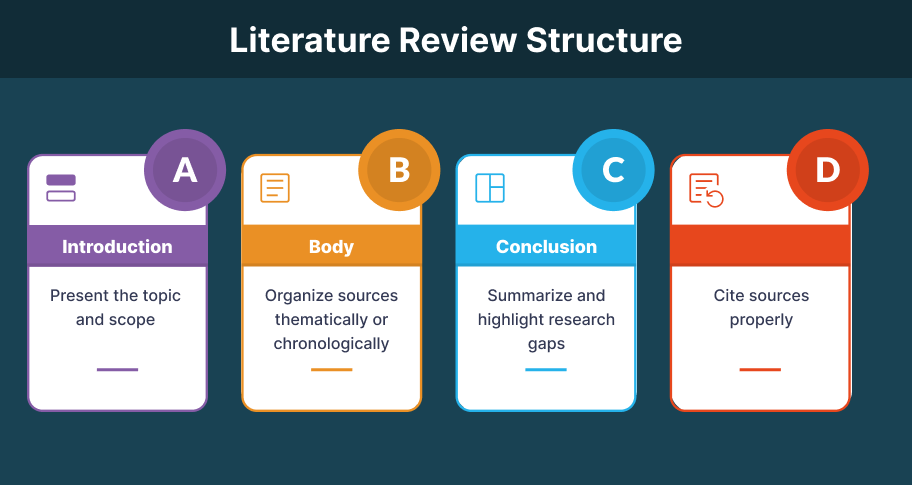
Steps to Writing a Literature Review
Writing a literature review can seem like a lot to take on. However, it is a very manageable process when you break it down into simple steps. Here’s our step-by-step guide on how to write a literature review.
Step 1: Select a Topic
The first step in writing a literature review is to choose a topic that is relevant and interesting to your research field. It should align with your research objectives. It should be specific and focused. Don’t make it too broad—but also don’t make it so narrow that you can’t find any research on it at all. You want there to be ample literature available to review. Your research will build on that.
Tip : Focus on a specific research question that your literature review will address. Try using field relevant keywords when you search ideas in literature databases.
Step 2: Search for Relevant Literature
Once your topic is chosen, conduct a thorough search for academic sources. Use databases like PubMed, JSTOR, or Google Scholar to find peer-reviewed articles, books, and conference papers.
- Use keywords related to your topic.
- Apply filters like publication date and research area.
- Search in libraries, academic journals, and trusted repositories.
Step 3: Evaluate and Analyze the Sources
Not all sources are created equal. Critically evaluate the quality and relevance of the literature. Consider the credibility of the author, the validity of the research methods, and the significance of the findings.
Criteria for Evaluation
- Author’s credentials and publication source
- Research design and methodology
- The study’s contribution to the field
Step 4: Organize the Literature
Organize your sources based on common themes, methodologies, findings, or the chronological development of ideas. A well-structured literature review outline can help. For example, you may categorize studies based on:
- Theoretical concepts
- Methodological approaches
- Historical progression
Organization Tips
- Use thematic or chronological order to maintain a coherent review.
- Identify major trends and seminal works in the field.
Step 5: Write the Literature Review
When writing, strive for a balanced discussion. Do not just summarize; synthesize and analyze. Critique the sources. Discuss the findings in a way that brings information in from multiple studies. Point out agreements, contradictions, and unanswered questions among the various sources.
Writing Tips
- Start each section with a strong topic sentence.
- Use clear and concise language.
- Maintain an objective tone, and do not inject personal opinions.
Literature Review Format
- Introduction: Present your research question and explain the purpose of the review.
- Body: Discuss studies in a structured manner.
- Conclusion: Summarize key findings and suggest future research directions.
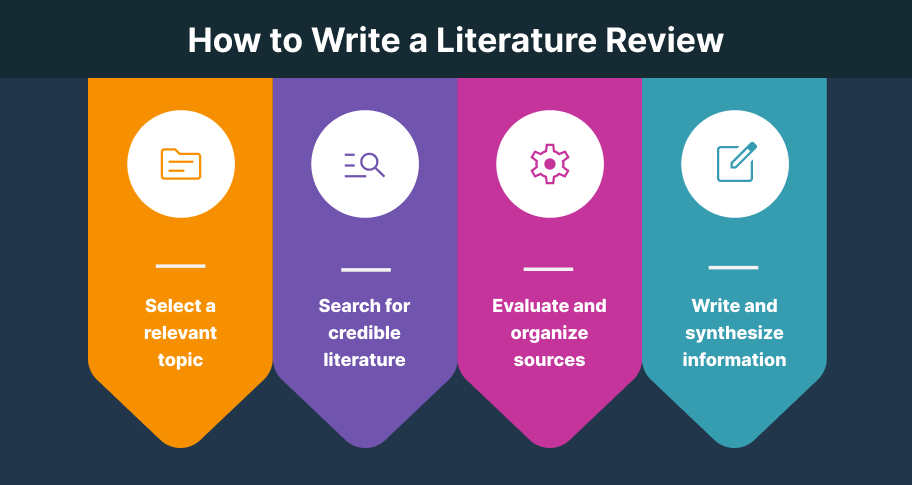
Structure of a Literature Review
A literature review typically follows a standard structure.
Introduce your topic and explain the review’s purpose. Clearly define the scope and outline the organization of the review.
The body is where you organize your sources. This can be done thematically (grouping similar studies together) or chronologically (presenting research in order of publication). Integrate studies by discussing their contributions and limitations.
Important Reminders
- Use transition words to maintain a logical flow.
- Highlight influential works and major shifts in the research.
Summarize the insights gained from your review. Highlight research gaps and suggest directions for future study. This section also emphasizes the significance of your research within the broader academic context.
Literature Review Example
The Impact of Social Media on Adolescent Mental Health
Here is our literature review example to show you how yours can look.
Social media usage among adolescents has sparked concern among mental health professionals (Uhls et al., 2017). Given that young people today are among the most active social media users, it is important to know how these platforms impact their psychological well-being. Adolescents are at a developmental stage where identity and role confusion represent the major conflict of their age according to Erikson’s psychosocial model. Social media platforms provide a space for this dramatic conflict to play out in ways that researchers are still trying to understand (Best et al., 2014).
Numerous studies have explored the relationship between social media engagement and various mental health outcomes (Maktelow & Taylor, 2014; Przybylski et al., 2013; Uhls et al., 2017). However, the findings are often mixed, and show both beneficial and harmful effects. This literature review focuses on the positive aspects of social media, such as peer support, the negative outcomes like heightened anxiety and depression, and the limitations inherent in the methodologies used by these studies.
Positive Impacts of Social Media: Peer Support and Connection
Research on the positive implications of social media for adolescent mental health indicates that these platforms have a lot to do with how social connections are established and the extent to which peer support is obtained (Best et al., 2014). Social media can promote a sense of belonging and provide adolescents with emotional support from their peers (Best et al., 2014). These online interactions can be beneficial for adolescents who experience social isolation or struggle with face-to-face interactions (Uhls et al., 2017). The ability to connect with peers who share similar experiences or interests can give a level of emotional affirmation that traditional offline interactions sometimes lack.
Uhls et al. (2017) described the importance of online communities in providing adolescents with opportunities for social engagement and self-expression, suggesting that these platforms allow teens to seek advice, share personal experiences, and receive encouragement, which can contribute positively to their self-esteem. Adolescents experiencing challenges such as bullying or family issues often turn to social media communities for support and validation, where they feel understood and less alone. In this way, the social connectivity afforded by platforms like Facebook, Instagram, and Snapchat can enhance adolescents’ overall well-being and promote resilience.

Negative Consequences of Social Media: Anxiety, Depression, and Self-Esteem Issues
Even though social media can offer emotional benefits, extensive evidence also points to its potential to harm adolescent mental health. One of the most frequently documented adverse outcomes is increased anxiety and depression linked to excessive social media use (Twenge & Campbell, 2018). Twenge and Campbell (2018) conducted a large-scale study that revealed a correlation between high levels of social media engagement and rising rates of depressive symptoms among teenagers. The researchers argued that the constant exposure to curated and often idealized representations of others’ lives led to feelings of inadequacy, poor self-image, and heightened anxiety. Adolescents may feel pressured to project a perfect image of themselves online, which can be exhausting and detrimental to their self-esteem.
Moreover, the concept of “fear of missing out” (FOMO) has emerged as a significant factor contributing to adolescent anxiety. FOMO refers to the pervasive apprehension that others are having rewarding experiences from which one is absent (Przybylski et al., 2013). Adolescents who experience FOMO are more likely to engage in compulsive social media checking, which disrupts their daily routines, sleep patterns, and academic performance (Przybylski et al., 2013). This behavior creates a cycle of anxiety and stress, as constant comparison and the need to remain connected exacerbate feelings of inadequacy.
Another area of concern is the impact of cyberbullying, which has become increasingly common with the advent of social media. Patchin and Hinduja (2015) found that victims of online harassment are more likely to experience severe psychological distress, like suicidal ideation and self-harm. Unlike traditional bullying, cyberbullying can occur at any time and is often anonymous, making it particularly relentless and damaging. The permanence of online interactions means that harmful content can be shared and viewed repeatedly, amplifying the psychological toll on victims. As a result, the mental health repercussions of cyberbullying can be profound and long-lasting.
Methodological Limitations in Existing Research
Despite the wealth of research on the relationship between social media and adolescent mental health, several methodological limitations complicate the interpretation of findings. One significant challenge is the reliance on self-reported data, which can be subject to bias. Adolescents may not accurately recall or may choose to underreport the extent of their social media use or the severity of their psychological symptoms (Keles et al., 2020). Reliance on self-reported measures makes it difficult to establish causal relationships between social media use and mental health outcomes.
Furthermore, many studies use cross-sectional designs, which cannot determine the directionality of the relationship between social media use and mental health (Patchin & Hinduja, 2015). It remains unclear whether increased social media use leads to poorer mental health or if adolescents struggling with mental health issues are more likely to seek out social media as a coping mechanism. Longitudinal research is needed to better understand the temporal dynamics of this relationship. The heterogeneity of social media platforms also complicates research, as different platforms may have unique features that affect users differently.. For example, visual platforms like Instagram may have a different psychological impact than text-based platforms like Twitter, and few if any studies have accounted for these nuances.
Another limitation involves the cultural context of social media use. Much of the research is conducted in Western countries, primarily the United States and Europe, which may not fully capture the full experience of adolescent social media engagement. Cultural differences in social norms, values, and access to technology can influence how adolescents use social media and how it affects their well-being. Thus, a culturally diverse research approach may be necessary to draw the most applicable conclusions.
The impact of social media on adolescent mental health has positive and negative dimensions. Social media platforms offer adolescents opportunities to seek peer support and partake of social engagement. At the same time there is the risk of excessive use and negative experiences, such as cyberbullying and FOMO, which are linked to increased anxiety, depression, and self-esteem issues. Existing research reveals methodological limitations such as self-reported data, cross-sectional designs, and a lack of cultural diversity in studies. Future research should focus on longitudinal studies and culturally sensitive approaches for a fuller understanding of how social media influences adolescent mental health. Moreover, intervention strategies that teach adolescents healthy social media habits and provide resources for coping with online stressors may be needed.
Best, P., Manktelow, R., & Taylor, B. (2014). Online communication, social media and adolescent wellbeing: A systematic narrative review. Children and Youth Services Review , 41, 27-36.
Keles, B., McCrae, N., & Grealish, A. (2020). A systematic review: The influence of social media on depression, anxiety, and psychological distress in adolescents. International Journal of Adolescence and Youth , 25(1), 79-93.
Patchin, J. W., & Hinduja, S. (2015). Measuring cyberbullying: Implications for research. Aggression and Violent Behavior , 23, 69-74.
Przybylski, A. K., Murayama, K., DeHaan, C. R., & Gladwell, V. (2013). Motivational, emotional, and behavioral correlates of fear of missing out. Computers in Human Behavior , 29(4), 1841-1848.
Twenge, J. M., & Campbell, W. K. (2018). Associations between screen time and lower psychological well-being among children and adolescents: Evidence from a population-based study. Preventive Medicine Reports , 12, 271-283.
Uhls, Y. T., Ellison, N. B., & Subrahmanyam, K. (2017). Benefits and costs of social media in adolescence. Pediatrics , 140(Supplement 2), S67-S70.
APA Literature Review Format
When writing in APA style, an APA literature review must follow specific guidelines for citation and formatting.

APA Formatting Guidelines
- Title Page : Include the title, author’s name, and institutional affiliation.
- Abstract : A brief summary of your review (usually 150-250 words).
- In-text Citations : Use the author-date citation method (e.g., Smith, 2020).
- Reference List : Provide full citations for all referenced works in alphabetical order.
Tips : Always adhere to the latest APA manual for formatting rules.
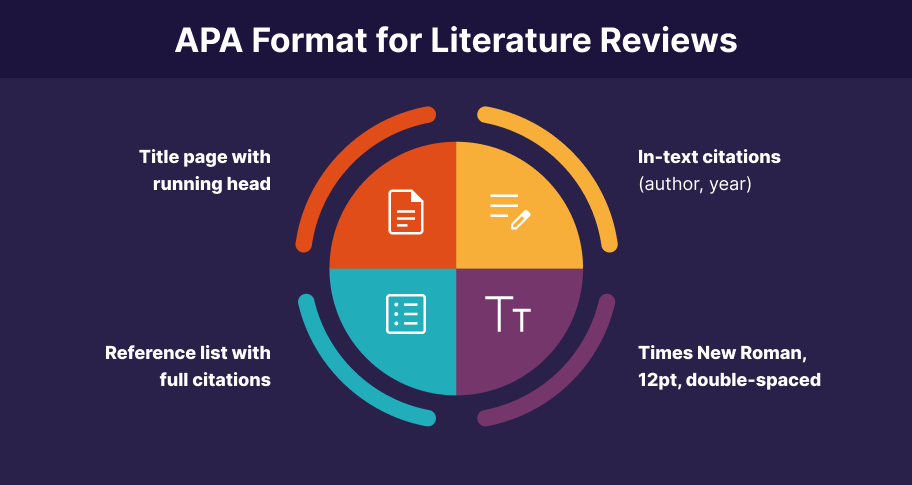
Literature Review Templates
A literature review template can simplify the process of organizing your review. You can find templates for APA, MLA, or Harvard formats at Purdue OWL . These templates provide a ready-to-use framework, so that your review is well-structured.
Common Mistakes to Avoid When Writing a Literature Review
Even experienced researchers can fall into common pitfalls. Here’s what to avoid:
- Lack of Focus : Make sure your review addresses a clear research question.
- Poor Organization : Avoid a scattered presentation. Use an outline to maintain structure.
- Failure to Synthesize : Do not just list sources. Instead, integrate and compare studies to show meaningful conclusions.
- Outdated Sources : Always use recent and relevant research unless discussing foundational theories.
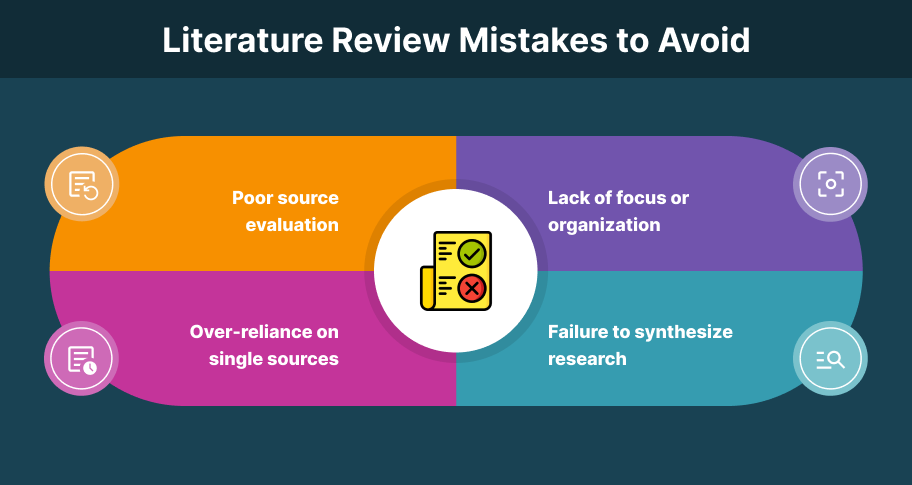
Literature Review FAQ
How long should a literature review be?
The length depends on the purpose and scope of your study. A literature review for a dissertation is typically longer than one for a research paper.
Can I include non-academic sources in a literature review?
Generally, it’s best to prioritize peer-reviewed and scholarly sources. However, in some cases, reputable non-academic sources may be used to provide additional context.
How do I structure a literature review for a dissertation?
Follow a detailed outline that includes an introduction, a well-organized body (thematic or chronological), and a concise conclusion. Discuss theories, methodologies, and identify research gaps.
Writing a literature review may seem like a tremendous challenge, but don’t give up! Use our tips and idea, maintain focus, and take it step by step. You’ll find that with a structured approach, even an inexperienced researcher can quickly gain a feel for how to write a literature review! Remember, a well-organized review can help you identify gaps that your own research can fill. Don’t skip on your lit review—dive in and use it to make your research thesis or dissertation even better.
Still need assistance with your literature review? View or download our free literature review worksheet to help get you started.
Take the first step to becoming a better academic writer.
Writing tools.
- How to write a research proposal 2021 guide
- Guide to citing in MLA
- Guide to citing in APA format
- Chicago style citation guide
- Harvard referencing and citing guide
- How to complete an informative essay outline
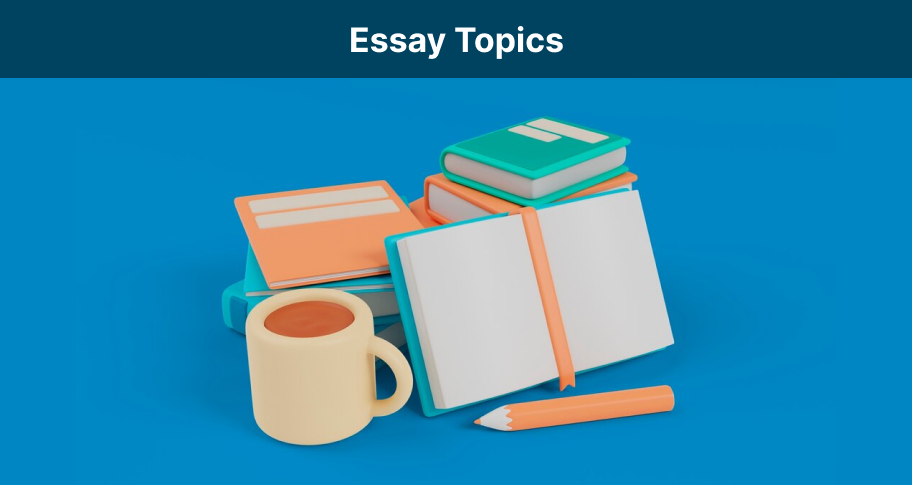
How to Choose the Best Essay Topics

AI Text Detection Services

Unlock Your Writing Potential with Our AI Essay Writing Assistant

The Negative Impacts of Artificial Intelligence on Tactile Learning
Purdue Online Writing Lab Purdue OWL® College of Liberal Arts
Writing a Literature Review

Welcome to the Purdue OWL
This page is brought to you by the OWL at Purdue University. When printing this page, you must include the entire legal notice.
Copyright ©1995-2018 by The Writing Lab & The OWL at Purdue and Purdue University. All rights reserved. This material may not be published, reproduced, broadcast, rewritten, or redistributed without permission. Use of this site constitutes acceptance of our terms and conditions of fair use.
A literature review is a document or section of a document that collects key sources on a topic and discusses those sources in conversation with each other (also called synthesis ). The lit review is an important genre in many disciplines, not just literature (i.e., the study of works of literature such as novels and plays). When we say “literature review” or refer to “the literature,” we are talking about the research ( scholarship ) in a given field. You will often see the terms “the research,” “the scholarship,” and “the literature” used mostly interchangeably.
Where, when, and why would I write a lit review?
There are a number of different situations where you might write a literature review, each with slightly different expectations; different disciplines, too, have field-specific expectations for what a literature review is and does. For instance, in the humanities, authors might include more overt argumentation and interpretation of source material in their literature reviews, whereas in the sciences, authors are more likely to report study designs and results in their literature reviews; these differences reflect these disciplines’ purposes and conventions in scholarship. You should always look at examples from your own discipline and talk to professors or mentors in your field to be sure you understand your discipline’s conventions, for literature reviews as well as for any other genre.
A literature review can be a part of a research paper or scholarly article, usually falling after the introduction and before the research methods sections. In these cases, the lit review just needs to cover scholarship that is important to the issue you are writing about; sometimes it will also cover key sources that informed your research methodology.
Lit reviews can also be standalone pieces, either as assignments in a class or as publications. In a class, a lit review may be assigned to help students familiarize themselves with a topic and with scholarship in their field, get an idea of the other researchers working on the topic they’re interested in, find gaps in existing research in order to propose new projects, and/or develop a theoretical framework and methodology for later research. As a publication, a lit review usually is meant to help make other scholars’ lives easier by collecting and summarizing, synthesizing, and analyzing existing research on a topic. This can be especially helpful for students or scholars getting into a new research area, or for directing an entire community of scholars toward questions that have not yet been answered.
What are the parts of a lit review?
Most lit reviews use a basic introduction-body-conclusion structure; if your lit review is part of a larger paper, the introduction and conclusion pieces may be just a few sentences while you focus most of your attention on the body. If your lit review is a standalone piece, the introduction and conclusion take up more space and give you a place to discuss your goals, research methods, and conclusions separately from where you discuss the literature itself.
Introduction:
- An introductory paragraph that explains what your working topic and thesis is
- A forecast of key topics or texts that will appear in the review
- Potentially, a description of how you found sources and how you analyzed them for inclusion and discussion in the review (more often found in published, standalone literature reviews than in lit review sections in an article or research paper)
- Summarize and synthesize: Give an overview of the main points of each source and combine them into a coherent whole
- Analyze and interpret: Don’t just paraphrase other researchers – add your own interpretations where possible, discussing the significance of findings in relation to the literature as a whole
- Critically Evaluate: Mention the strengths and weaknesses of your sources
- Write in well-structured paragraphs: Use transition words and topic sentence to draw connections, comparisons, and contrasts.
Conclusion:
- Summarize the key findings you have taken from the literature and emphasize their significance
- Connect it back to your primary research question
How should I organize my lit review?
Lit reviews can take many different organizational patterns depending on what you are trying to accomplish with the review. Here are some examples:
- Chronological : The simplest approach is to trace the development of the topic over time, which helps familiarize the audience with the topic (for instance if you are introducing something that is not commonly known in your field). If you choose this strategy, be careful to avoid simply listing and summarizing sources in order. Try to analyze the patterns, turning points, and key debates that have shaped the direction of the field. Give your interpretation of how and why certain developments occurred (as mentioned previously, this may not be appropriate in your discipline — check with a teacher or mentor if you’re unsure).
- Thematic : If you have found some recurring central themes that you will continue working with throughout your piece, you can organize your literature review into subsections that address different aspects of the topic. For example, if you are reviewing literature about women and religion, key themes can include the role of women in churches and the religious attitude towards women.
- Qualitative versus quantitative research
- Empirical versus theoretical scholarship
- Divide the research by sociological, historical, or cultural sources
- Theoretical : In many humanities articles, the literature review is the foundation for the theoretical framework. You can use it to discuss various theories, models, and definitions of key concepts. You can argue for the relevance of a specific theoretical approach or combine various theorical concepts to create a framework for your research.
What are some strategies or tips I can use while writing my lit review?
Any lit review is only as good as the research it discusses; make sure your sources are well-chosen and your research is thorough. Don’t be afraid to do more research if you discover a new thread as you’re writing. More info on the research process is available in our "Conducting Research" resources .
As you’re doing your research, create an annotated bibliography ( see our page on the this type of document ). Much of the information used in an annotated bibliography can be used also in a literature review, so you’ll be not only partially drafting your lit review as you research, but also developing your sense of the larger conversation going on among scholars, professionals, and any other stakeholders in your topic.
Usually you will need to synthesize research rather than just summarizing it. This means drawing connections between sources to create a picture of the scholarly conversation on a topic over time. Many student writers struggle to synthesize because they feel they don’t have anything to add to the scholars they are citing; here are some strategies to help you:
- It often helps to remember that the point of these kinds of syntheses is to show your readers how you understand your research, to help them read the rest of your paper.
- Writing teachers often say synthesis is like hosting a dinner party: imagine all your sources are together in a room, discussing your topic. What are they saying to each other?
- Look at the in-text citations in each paragraph. Are you citing just one source for each paragraph? This usually indicates summary only. When you have multiple sources cited in a paragraph, you are more likely to be synthesizing them (not always, but often
- Read more about synthesis here.
The most interesting literature reviews are often written as arguments (again, as mentioned at the beginning of the page, this is discipline-specific and doesn’t work for all situations). Often, the literature review is where you can establish your research as filling a particular gap or as relevant in a particular way. You have some chance to do this in your introduction in an article, but the literature review section gives a more extended opportunity to establish the conversation in the way you would like your readers to see it. You can choose the intellectual lineage you would like to be part of and whose definitions matter most to your thinking (mostly humanities-specific, but this goes for sciences as well). In addressing these points, you argue for your place in the conversation, which tends to make the lit review more compelling than a simple reporting of other sources.
- USC Libraries
- Research Guides
Organizing Your Social Sciences Research Paper
- 5. The Literature Review
- Purpose of Guide
- Design Flaws to Avoid
- Independent and Dependent Variables
- Glossary of Research Terms
- Reading Research Effectively
- Narrowing a Topic Idea
- Broadening a Topic Idea
- Extending the Timeliness of a Topic Idea
- Academic Writing Style
- Applying Critical Thinking
- Choosing a Title
- Making an Outline
- Paragraph Development
- Research Process Video Series
- Executive Summary
- The C.A.R.S. Model
- Background Information
- The Research Problem/Question
- Theoretical Framework
- Citation Tracking
- Content Alert Services
- Evaluating Sources
- Primary Sources
- Secondary Sources
- Tiertiary Sources
- Scholarly vs. Popular Resources
- Qualitative Methods
- Quantitative Methods
- Insiderness
- Using Non-Textual Elements
- Limitations of the Study
- Common Grammar Mistakes
- Writing Concisely
- Avoiding Plagiarism
- Footnotes or Endnotes?
- Further Readings
- Generative AI and Writing
- USC Libraries Tutorials and Other Guides
- Bibliography
A literature review surveys prior research published in books, scholarly articles, and any other sources relevant to a particular issue, area of research, or theory, and by so doing, provides a description, summary, and critical evaluation of these works in relation to the research problem being investigated. Literature reviews are designed to provide an overview of sources you have used in researching a particular topic and to demonstrate to your readers how your research fits within existing scholarship about the topic.
Fink, Arlene. Conducting Research Literature Reviews: From the Internet to Paper . Fourth edition. Thousand Oaks, CA: SAGE, 2014.
Importance of a Good Literature Review
A literature review may consist of simply a summary of key sources, but in the social sciences, a literature review usually has an organizational pattern and combines both summary and synthesis, often within specific conceptual categories . A summary is a recap of the important information of the source, but a synthesis is a re-organization, or a reshuffling, of that information in a way that informs how you are planning to investigate a research problem. The analytical features of a literature review might:
- Give a new interpretation of old material or combine new with old interpretations,
- Trace the intellectual progression of the field, including major debates,
- Depending on the situation, evaluate the sources and advise the reader on the most pertinent or relevant research, or
- Usually in the conclusion of a literature review, identify where gaps exist in how a problem has been researched to date.
Given this, the purpose of a literature review is to:
- Place each work in the context of its contribution to understanding the research problem being studied.
- Describe the relationship of each work to the others under consideration.
- Identify new ways to interpret prior research.
- Reveal any gaps that exist in the literature.
- Resolve conflicts amongst seemingly contradictory previous studies.
- Identify areas of prior scholarship to prevent duplication of effort.
- Point the way in fulfilling a need for additional research.
- Locate your own research within the context of existing literature [very important].
Fink, Arlene. Conducting Research Literature Reviews: From the Internet to Paper. 2nd ed. Thousand Oaks, CA: Sage, 2005; Hart, Chris. Doing a Literature Review: Releasing the Social Science Research Imagination . Thousand Oaks, CA: Sage Publications, 1998; Jesson, Jill. Doing Your Literature Review: Traditional and Systematic Techniques . Los Angeles, CA: SAGE, 2011; Knopf, Jeffrey W. "Doing a Literature Review." PS: Political Science and Politics 39 (January 2006): 127-132; Ridley, Diana. The Literature Review: A Step-by-Step Guide for Students . 2nd ed. Los Angeles, CA: SAGE, 2012.
Types of Literature Reviews
It is important to think of knowledge in a given field as consisting of three layers. First, there are the primary studies that researchers conduct and publish. Second are the reviews of those studies that summarize and offer new interpretations built from and often extending beyond the primary studies. Third, there are the perceptions, conclusions, opinion, and interpretations that are shared informally among scholars that become part of the body of epistemological traditions within the field.
In composing a literature review, it is important to note that it is often this third layer of knowledge that is cited as "true" even though it often has only a loose relationship to the primary studies and secondary literature reviews. Given this, while literature reviews are designed to provide an overview and synthesis of pertinent sources you have explored, there are a number of approaches you could adopt depending upon the type of analysis underpinning your study.
Argumentative Review This form examines literature selectively in order to support or refute an argument, deeply embedded assumption, or philosophical problem already established in the literature. The purpose is to develop a body of literature that establishes a contrarian viewpoint. Given the value-laden nature of some social science research [e.g., educational reform; immigration control], argumentative approaches to analyzing the literature can be a legitimate and important form of discourse. However, note that they can also introduce problems of bias when they are used to make summary claims of the sort found in systematic reviews [see below].
Integrative Review Considered a form of research that reviews, critiques, and synthesizes representative literature on a topic in an integrated way such that new frameworks and perspectives on the topic are generated. The body of literature includes all studies that address related or identical hypotheses or research problems. A well-done integrative review meets the same standards as primary research in regard to clarity, rigor, and replication. This is the most common form of review in the social sciences.
Historical Review Few things rest in isolation from historical precedent. Historical literature reviews focus on examining research throughout a period of time, often starting with the first time an issue, concept, theory, phenomena emerged in the literature, then tracing its evolution within the scholarship of a discipline. The purpose is to place research in a historical context to show familiarity with state-of-the-art developments and to identify the likely directions for future research.
Methodological Review A review does not always focus on what someone said [findings], but how they came about saying what they say [method of analysis]. Reviewing methods of analysis provides a framework of understanding at different levels [i.e. those of theory, substantive fields, research approaches, and data collection and analysis techniques], how researchers draw upon a wide variety of knowledge ranging from the conceptual level to practical documents for use in fieldwork in the areas of ontological and epistemological consideration, quantitative and qualitative integration, sampling, interviewing, data collection, and data analysis. This approach helps highlight ethical issues which you should be aware of and consider as you go through your own study.
Systematic Review This form consists of an overview of existing evidence pertinent to a clearly formulated research question, which uses pre-specified and standardized methods to identify and critically appraise relevant research, and to collect, report, and analyze data from the studies that are included in the review. The goal is to deliberately document, critically evaluate, and summarize scientifically all of the research about a clearly defined research problem . Typically it focuses on a very specific empirical question, often posed in a cause-and-effect form, such as "To what extent does A contribute to B?" This type of literature review is primarily applied to examining prior research studies in clinical medicine and allied health fields, but it is increasingly being used in the social sciences.
Theoretical Review The purpose of this form is to examine the corpus of theory that has accumulated in regard to an issue, concept, theory, phenomena. The theoretical literature review helps to establish what theories already exist, the relationships between them, to what degree the existing theories have been investigated, and to develop new hypotheses to be tested. Often this form is used to help establish a lack of appropriate theories or reveal that current theories are inadequate for explaining new or emerging research problems. The unit of analysis can focus on a theoretical concept or a whole theory or framework.
NOTE: Most often the literature review will incorporate some combination of types. For example, a review that examines literature supporting or refuting an argument, assumption, or philosophical problem related to the research problem will also need to include writing supported by sources that establish the history of these arguments in the literature.
Baumeister, Roy F. and Mark R. Leary. "Writing Narrative Literature Reviews." Review of General Psychology 1 (September 1997): 311-320; Mark R. Fink, Arlene. Conducting Research Literature Reviews: From the Internet to Paper . 2nd ed. Thousand Oaks, CA: Sage, 2005; Hart, Chris. Doing a Literature Review: Releasing the Social Science Research Imagination . Thousand Oaks, CA: Sage Publications, 1998; Kennedy, Mary M. "Defining a Literature." Educational Researcher 36 (April 2007): 139-147; Petticrew, Mark and Helen Roberts. Systematic Reviews in the Social Sciences: A Practical Guide . Malden, MA: Blackwell Publishers, 2006; Torracro, Richard. "Writing Integrative Literature Reviews: Guidelines and Examples." Human Resource Development Review 4 (September 2005): 356-367; Rocco, Tonette S. and Maria S. Plakhotnik. "Literature Reviews, Conceptual Frameworks, and Theoretical Frameworks: Terms, Functions, and Distinctions." Human Ressource Development Review 8 (March 2008): 120-130; Sutton, Anthea. Systematic Approaches to a Successful Literature Review . Los Angeles, CA: Sage Publications, 2016.
Structure and Writing Style
I. Thinking About Your Literature Review
The structure of a literature review should include the following in support of understanding the research problem :
- An overview of the subject, issue, or theory under consideration, along with the objectives of the literature review,
- Division of works under review into themes or categories [e.g. works that support a particular position, those against, and those offering alternative approaches entirely],
- An explanation of how each work is similar to and how it varies from the others,
- Conclusions as to which pieces are best considered in their argument, are most convincing of their opinions, and make the greatest contribution to the understanding and development of their area of research.
The critical evaluation of each work should consider :
- Provenance -- what are the author's credentials? Are the author's arguments supported by evidence [e.g. primary historical material, case studies, narratives, statistics, recent scientific findings]?
- Methodology -- were the techniques used to identify, gather, and analyze the data appropriate to addressing the research problem? Was the sample size appropriate? Were the results effectively interpreted and reported?
- Objectivity -- is the author's perspective even-handed or prejudicial? Is contrary data considered or is certain pertinent information ignored to prove the author's point?
- Persuasiveness -- which of the author's theses are most convincing or least convincing?
- Validity -- are the author's arguments and conclusions convincing? Does the work ultimately contribute in any significant way to an understanding of the subject?
II. Development of the Literature Review
Four Basic Stages of Writing 1. Problem formulation -- which topic or field is being examined and what are its component issues? 2. Literature search -- finding materials relevant to the subject being explored. 3. Data evaluation -- determining which literature makes a significant contribution to the understanding of the topic. 4. Analysis and interpretation -- discussing the findings and conclusions of pertinent literature.
Consider the following issues before writing the literature review: Clarify If your assignment is not specific about what form your literature review should take, seek clarification from your professor by asking these questions: 1. Roughly how many sources would be appropriate to include? 2. What types of sources should I review (books, journal articles, websites; scholarly versus popular sources)? 3. Should I summarize, synthesize, or critique sources by discussing a common theme or issue? 4. Should I evaluate the sources in any way beyond evaluating how they relate to understanding the research problem? 5. Should I provide subheadings and other background information, such as definitions and/or a history? Find Models Use the exercise of reviewing the literature to examine how authors in your discipline or area of interest have composed their literature review sections. Read them to get a sense of the types of themes you might want to look for in your own research or to identify ways to organize your final review. The bibliography or reference section of sources you've already read, such as required readings in the course syllabus, are also excellent entry points into your own research. Narrow the Topic The narrower your topic, the easier it will be to limit the number of sources you need to read in order to obtain a good survey of relevant resources. Your professor will probably not expect you to read everything that's available about the topic, but you'll make the act of reviewing easier if you first limit scope of the research problem. A good strategy is to begin by searching the USC Libraries Catalog for recent books about the topic and review the table of contents for chapters that focuses on specific issues. You can also review the indexes of books to find references to specific issues that can serve as the focus of your research. For example, a book surveying the history of the Israeli-Palestinian conflict may include a chapter on the role Egypt has played in mediating the conflict, or look in the index for the pages where Egypt is mentioned in the text. Consider Whether Your Sources are Current Some disciplines require that you use information that is as current as possible. This is particularly true in disciplines in medicine and the sciences where research conducted becomes obsolete very quickly as new discoveries are made. However, when writing a review in the social sciences, a survey of the history of the literature may be required. In other words, a complete understanding the research problem requires you to deliberately examine how knowledge and perspectives have changed over time. Sort through other current bibliographies or literature reviews in the field to get a sense of what your discipline expects. You can also use this method to explore what is considered by scholars to be a "hot topic" and what is not.
III. Ways to Organize Your Literature Review
Chronology of Events If your review follows the chronological method, you could write about the materials according to when they were published. This approach should only be followed if a clear path of research building on previous research can be identified and that these trends follow a clear chronological order of development. For example, a literature review that focuses on continuing research about the emergence of German economic power after the fall of the Soviet Union. By Publication Order your sources by publication chronology, then, only if the order demonstrates a more important trend. For instance, you could order a review of literature on environmental studies of brown fields if the progression revealed, for example, a change in the soil collection practices of the researchers who wrote and/or conducted the studies. Thematic [“conceptual categories”] A thematic literature review is the most common approach to summarizing prior research in the social and behavioral sciences. Thematic reviews are organized around a topic or issue, rather than the progression of time, although the progression of time may still be incorporated into a thematic review. For example, a review of the Internet’s impact on American presidential politics could focus on the development of online political satire. While the study focuses on one topic, the Internet’s impact on American presidential politics, it would still be organized chronologically reflecting technological developments in media. The difference in this example between a "chronological" and a "thematic" approach is what is emphasized the most: themes related to the role of the Internet in presidential politics. Note that more authentic thematic reviews tend to break away from chronological order. A review organized in this manner would shift between time periods within each section according to the point being made. Methodological A methodological approach focuses on the methods utilized by the researcher. For the Internet in American presidential politics project, one methodological approach would be to look at cultural differences between the portrayal of American presidents on American, British, and French websites. Or the review might focus on the fundraising impact of the Internet on a particular political party. A methodological scope will influence either the types of documents in the review or the way in which these documents are discussed.
Other Sections of Your Literature Review Once you've decided on the organizational method for your literature review, the sections you need to include in the paper should be easy to figure out because they arise from your organizational strategy. In other words, a chronological review would have subsections for each vital time period; a thematic review would have subtopics based upon factors that relate to the theme or issue. However, sometimes you may need to add additional sections that are necessary for your study, but do not fit in the organizational strategy of the body. What other sections you include in the body is up to you. However, only include what is necessary for the reader to locate your study within the larger scholarship about the research problem.
Here are examples of other sections, usually in the form of a single paragraph, you may need to include depending on the type of review you write:
- Current Situation : Information necessary to understand the current topic or focus of the literature review.
- Sources Used : Describes the methods and resources [e.g., databases] you used to identify the literature you reviewed.
- History : The chronological progression of the field, the research literature, or an idea that is necessary to understand the literature review, if the body of the literature review is not already a chronology.
- Selection Methods : Criteria you used to select (and perhaps exclude) sources in your literature review. For instance, you might explain that your review includes only peer-reviewed [i.e., scholarly] sources.
- Standards : Description of the way in which you present your information.
- Questions for Further Research : What questions about the field has the review sparked? How will you further your research as a result of the review?
IV. Writing Your Literature Review
Once you've settled on how to organize your literature review, you're ready to write each section. When writing your review, keep in mind these issues.
Use Evidence A literature review section is, in this sense, just like any other academic research paper. Your interpretation of the available sources must be backed up with evidence [citations] that demonstrates that what you are saying is valid. Be Selective Select only the most important points in each source to highlight in the review. The type of information you choose to mention should relate directly to the research problem, whether it is thematic, methodological, or chronological. Related items that provide additional information, but that are not key to understanding the research problem, can be included in a list of further readings . Use Quotes Sparingly Some short quotes are appropriate if you want to emphasize a point, or if what an author stated cannot be easily paraphrased. Sometimes you may need to quote certain terminology that was coined by the author, is not common knowledge, or taken directly from the study. Do not use extensive quotes as a substitute for using your own words in reviewing the literature. Summarize and Synthesize Remember to summarize and synthesize your sources within each thematic paragraph as well as throughout the review. Recapitulate important features of a research study, but then synthesize it by rephrasing the study's significance and relating it to your own work and the work of others. Keep Your Own Voice While the literature review presents others' ideas, your voice [the writer's] should remain front and center. For example, weave references to other sources into what you are writing but maintain your own voice by starting and ending the paragraph with your own ideas and wording. Use Caution When Paraphrasing When paraphrasing a source that is not your own, be sure to represent the author's information or opinions accurately and in your own words. Even when paraphrasing an author’s work, you still must provide a citation to that work.
V. Common Mistakes to Avoid
These are the most common mistakes made in reviewing social science research literature.
- Sources in your literature review do not clearly relate to the research problem;
- You do not take sufficient time to define and identify the most relevant sources to use in the literature review related to the research problem;
- Relies exclusively on secondary analytical sources rather than including relevant primary research studies or data;
- Uncritically accepts another researcher's findings and interpretations as valid, rather than examining critically all aspects of the research design and analysis;
- Does not describe the search procedures that were used in identifying the literature to review;
- Reports isolated statistical results rather than synthesizing them in chi-squared or meta-analytic methods; and,
- Only includes research that validates assumptions and does not consider contrary findings and alternative interpretations found in the literature.
Cook, Kathleen E. and Elise Murowchick. “Do Literature Review Skills Transfer from One Course to Another?” Psychology Learning and Teaching 13 (March 2014): 3-11; Fink, Arlene. Conducting Research Literature Reviews: From the Internet to Paper . 2nd ed. Thousand Oaks, CA: Sage, 2005; Hart, Chris. Doing a Literature Review: Releasing the Social Science Research Imagination . Thousand Oaks, CA: Sage Publications, 1998; Jesson, Jill. Doing Your Literature Review: Traditional and Systematic Techniques . London: SAGE, 2011; Literature Review Handout. Online Writing Center. Liberty University; Literature Reviews. The Writing Center. University of North Carolina; Onwuegbuzie, Anthony J. and Rebecca Frels. Seven Steps to a Comprehensive Literature Review: A Multimodal and Cultural Approach . Los Angeles, CA: SAGE, 2016; Ridley, Diana. The Literature Review: A Step-by-Step Guide for Students . 2nd ed. Los Angeles, CA: SAGE, 2012; Randolph, Justus J. “A Guide to Writing the Dissertation Literature Review." Practical Assessment, Research, and Evaluation. vol. 14, June 2009; Sutton, Anthea. Systematic Approaches to a Successful Literature Review . Los Angeles, CA: Sage Publications, 2016; Taylor, Dena. The Literature Review: A Few Tips On Conducting It. University College Writing Centre. University of Toronto; Writing a Literature Review. Academic Skills Centre. University of Canberra.
Writing Tip
Break Out of Your Disciplinary Box!
Thinking interdisciplinarily about a research problem can be a rewarding exercise in applying new ideas, theories, or concepts to an old problem. For example, what might cultural anthropologists say about the continuing conflict in the Middle East? In what ways might geographers view the need for better distribution of social service agencies in large cities than how social workers might study the issue? You don’t want to substitute a thorough review of core research literature in your discipline for studies conducted in other fields of study. However, particularly in the social sciences, thinking about research problems from multiple vectors is a key strategy for finding new solutions to a problem or gaining a new perspective. Consult with a librarian about identifying research databases in other disciplines; almost every field of study has at least one comprehensive database devoted to indexing its research literature.
Frodeman, Robert. The Oxford Handbook of Interdisciplinarity . New York: Oxford University Press, 2010.
Another Writing Tip
Don't Just Review for Content!
While conducting a review of the literature, maximize the time you devote to writing this part of your paper by thinking broadly about what you should be looking for and evaluating. Review not just what scholars are saying, but how are they saying it. Some questions to ask:
- How are they organizing their ideas?
- What methods have they used to study the problem?
- What theories have been used to explain, predict, or understand their research problem?
- What sources have they cited to support their conclusions?
- How have they used non-textual elements [e.g., charts, graphs, figures, etc.] to illustrate key points?
When you begin to write your literature review section, you'll be glad you dug deeper into how the research was designed and constructed because it establishes a means for developing more substantial analysis and interpretation of the research problem.
Hart, Chris. Doing a Literature Review: Releasing the Social Science Research Imagination . Thousand Oaks, CA: Sage Publications, 1 998.
Yet Another Writing Tip
When Do I Know I Can Stop Looking and Move On?
Here are several strategies you can utilize to assess whether you've thoroughly reviewed the literature:
- Look for repeating patterns in the research findings . If the same thing is being said, just by different people, then this likely demonstrates that the research problem has hit a conceptual dead end. At this point consider: Does your study extend current research? Does it forge a new path? Or, does is merely add more of the same thing being said?
- Look at sources the authors cite to in their work . If you begin to see the same researchers cited again and again, then this is often an indication that no new ideas have been generated to address the research problem.
- Search Google Scholar to identify who has subsequently cited leading scholars already identified in your literature review [see next sub-tab]. This is called citation tracking and there are a number of sources that can help you identify who has cited whom, particularly scholars from outside of your discipline. Here again, if the same authors are being cited again and again, this may indicate no new literature has been written on the topic.
Onwuegbuzie, Anthony J. and Rebecca Frels. Seven Steps to a Comprehensive Literature Review: A Multimodal and Cultural Approach . Los Angeles, CA: Sage, 2016; Sutton, Anthea. Systematic Approaches to a Successful Literature Review . Los Angeles, CA: Sage Publications, 2016.
- << Previous: Theoretical Framework
- Next: Citation Tracking >>
- Last Updated: Nov 18, 2024 10:11 AM
- URL: https://libguides.usc.edu/writingguide

IMAGES
VIDEO